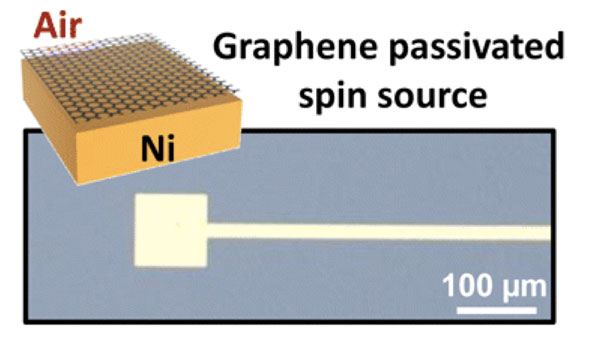Researchers in the UK, France and Germany have fabricated ferromagnetic electrodes that have been passivated with graphene. The electrodes, which are resistant to oxidation, could be ideal for use in spintronics devices for information storage applications.

Information storage is undergoing somewhat of a revolution with the advent of huge cloud computing centres around the world that will store and process unprecedented amounts of data. Spintronics – a technology that exploits the spin of an electron as well as its charge – is playing an important part in this revolution with ferromagnetic memory elements acting as basic building blocks, or "spin sources and detectors", in hard-drive read heads (containing spin valves) and MRAMs.
Spintronics devices store binary information using the spin of an electron, which can point in an "up" or "down" direction. Circuits using such a spin current (which consists of electrons with a well defined spin direction) are smaller and more efficient than conventional electronic circuits that rely on switching charge alone. This is because only a little energy is needed to switch spins from up to down.
Electrode oxidation is a problem
Spintronics devices work using spin-polarized electrodes that are typically made from ferromagnetic nickel and cobalt because they contain intrinsically spin-polarized electron populations – that is, different numbers of up spin and down spin electrons. However, the problem is that these metals are prone to oxidation, especially during device processing and integration.
A team from the University Paris-Sud, CNRS, Thales, the University of Cambridge and the Helmholtz-Zentrum Berlin fur Materialien und Energie may now have found a way of overcoming this problem. The researchers have designed a new type of hybrid inorganic/organic electrode made from stripes of nickel coated with a layer of graphene. The graphene is grown using a technique called chemical vapour deposition (CVD), a process that ensures that the nickel surface is reduced. The graphene coating layer then protects the nickel from oxidizing.
Passivated electrode as a spin source
Using tunnel spectroscopy, the researchers also found that electrons flowing perpendicularly though the graphene-passivated ferromagnetic electrode (GPFE) are spin polarized, which confirms that the GPFE can be used as a spin source. Previous research had already shown graphene to be a promising material for spintronics devices because it can serve as an excellent tunnel barrier when current is directed perpendicular to the plane of the graphene carbon atoms. It was also predicted that graphene in ferromagnetic spintronics structures might be able to switch the tunnel spin polarization at the interface between the two materials thanks to band-structure-derived "spin-filtering" effects. “We have now observed these effects in experiments in spin-valve devices we fabricated from the GPFE,” team member Bruno Dlubak of Cambridge told nanotechweb.org.
The work is detailed in ACS Nano.
About the author
Belle Dume is contributing editor at nanotechweb.org.

